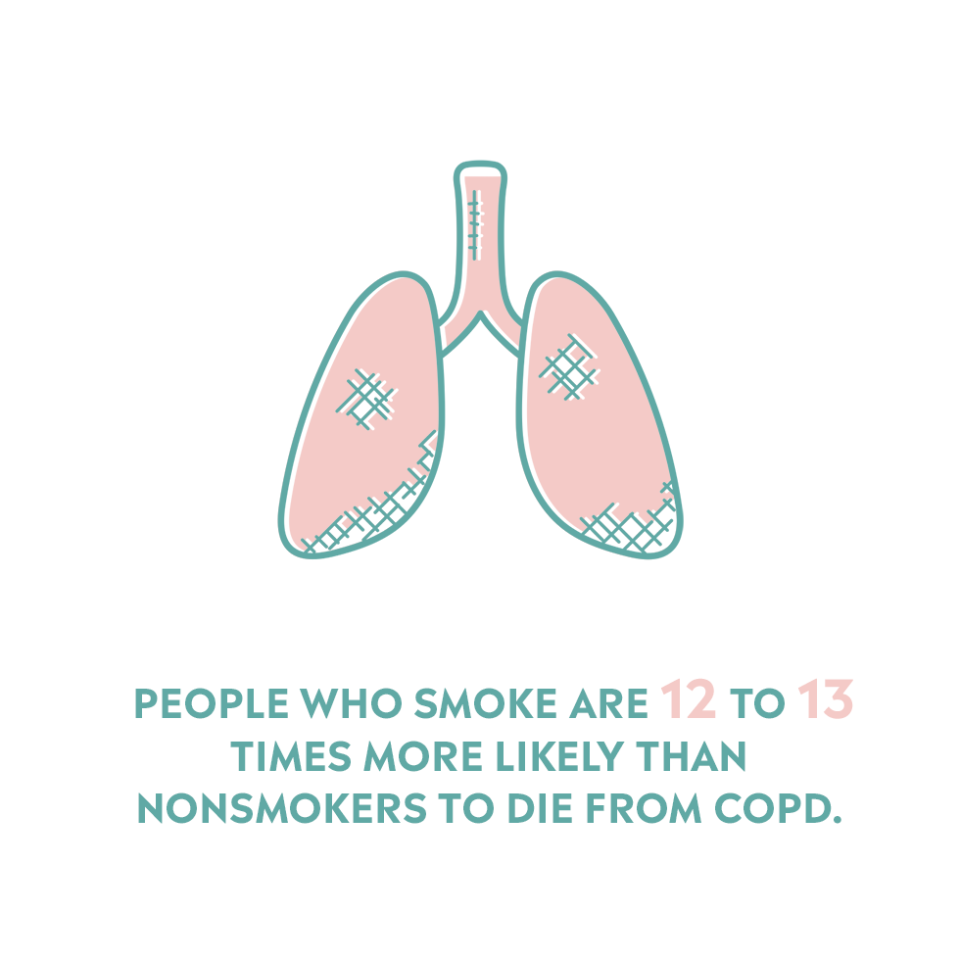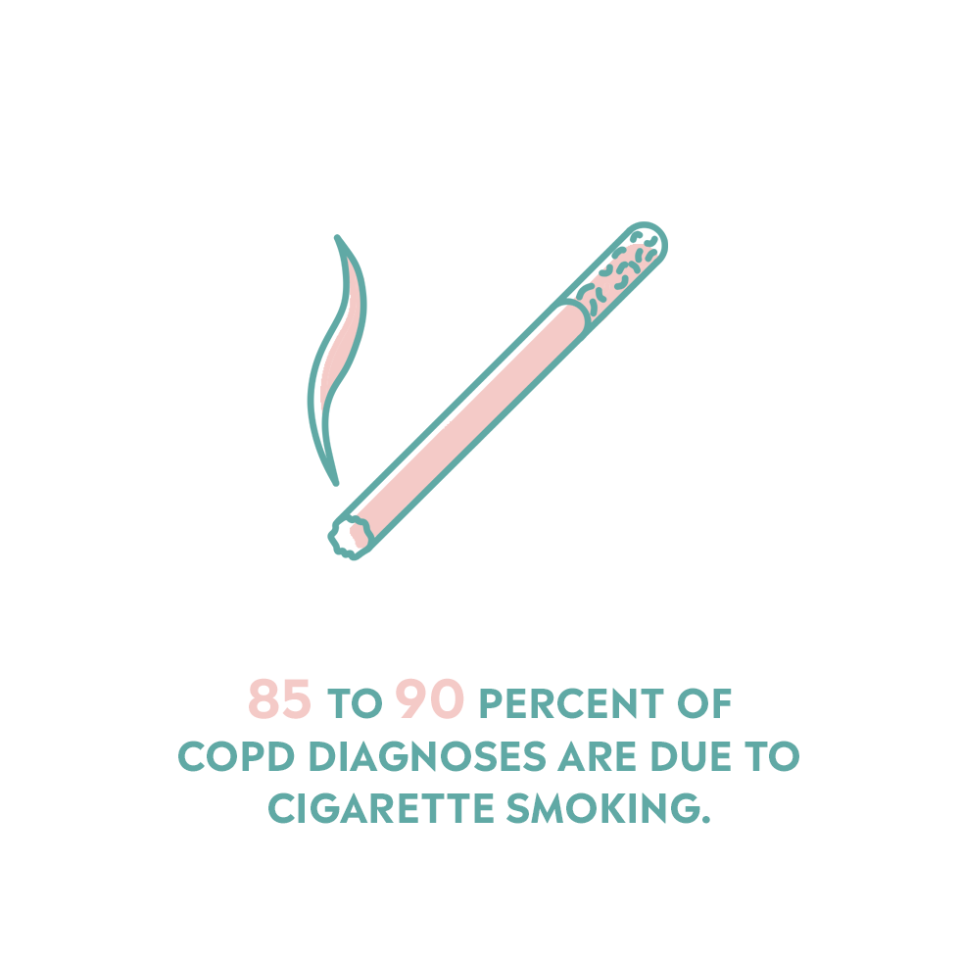Everything You Need to Know About COPD

Table of Contents
Overview | Causes | Symptoms | Diagnosis | Treatment | Complications | Prevention
What is COPD?
COPD stands for chronic obstructive pulmonary disease. The condition causes lung inflammation that leads to airflow blockage and breathing problems. [1] “COPD encompasses both emphysema and chronic bronchitis,” says Megan Dulohery Scrodin, M.D., a pulmonologist at the Mayo Clinic. [2]
With emphysema, the lung’s air sacs become damaged, and the sacs’ inner walls can deteriorate and rupture. With fewer and larger air sacs rather than several tiny ones, our lungs become less efficient at delivering oxygen to the bloodstream and eliminating carbon dioxide. [3, 4] “The worse the emphysema, the more damage there is to the air sacs, and the harder it is to breathe,” Dr. Dulohery Scrodin says.

When someone has chronic bronchitis, the lining of their bronchial tubes is constantly inflamed. This increases the production of mucus, which makes breathing more challenging. [3] “It’s like instead of breathing through a regular straw, you’re breathing through a tiny coffee straw,” Dr. Dulohery Scrodin says. In addition to shortness of breath, she adds, people with chronic bronchitis cough frequently, often with mucus.
Overall, there’s a spectrum of diseases with COPD, Dr. Dulohery Scrodin explains. Most of the more than 16 million Americans who have COPD have symptoms of both emphysema and chronic bronchitis, to varying degrees. [5] Others have just one condition. Regardless of the severity of the disease, there is no cure for COPD, and it is currently the third leading cause of death in the United States. [5]
What are the risk factors of COPD?
A range of factors can increase the risk of COPD, from sex to lifestyle habits to specific genetic markers. Here are the main ones to keep in mind.
[6, 7, 8, 9]
What are the symptoms of COPD?
The markers of the disease can be mistaken for everyday shortness of breath or simply signs of aging. However, as COPD worsens, so do the symptoms. If you notice any of the below—especially if the symptoms continue and/or grow more severe—talk to your doctor. [10]
Shortness of breath while doing everyday activities
Chronic cough (with or without mucus)
Wheezing (a whistling sound made when you breathe)
Frequent respiratory infections (think: colds, the flu, pneumonia, etc.)
Fatigue
Chest tightness [8]
How is COPD diagnosed?
Your doctor will talk to you about your symptoms and ask if you have any family history of the disease. Additionally, they’ll want to know if you smoke or ever have, and if you’ve ever been exposed to secondhand smoke, air pollution, or chemicals that could harm the lungs. [10,11]
Honesty is key. “If you have a history of smoking heavily or currently smoke, tell your doctor. This knowledge helps the doctor understand the risk of how quickly the lung disease may progress,” Dr. Dulohery Scrodin explains. “And if you don’t admit to smoking and they see signs of COPD, the doctor may recommend unnecessary testing that they would not do if they knew your full history.”

Additionally, your doctor may use a variety of tests to determine if you have COPD:
A spirometry is the primary diagnostic tool: You blow into a tube connected to a small machine, and the machine measures how much air you exhale and how quickly. The lower your scores, the worse your lung function, and the more likely it is that you have COPD. [12]
A chest x-ray can help identify emphysema and chronic bronchitis and rule out heart failure and other lung problems. [11]
An arterial blood gas test indicates how well the lungs are moving oxygen into—and removing carbon dioxide from—the blood. If you have COPD, your lungs’ ability to perform this basic function decreases. [10]
A CT scan of the lungs can reveal emphysema and screen for lung cancer. [11]
Complications during these tests are uncommon, Dr. Dulohery Scrodin says, so feel comfortable and confident in taking them if your doctor recommends it.
COPD treatment
How you address COPD depends on how severe the condition has become. If you smoke, quitting is essential; smoking exacerbates the disease and makes COPD medication less effective. [11] Certain lifestyle changes can also help. After that, the medical treatment for all patients with COPD symptoms is an inhaler, Dr. Dulohery Scrodin says. In more serious cases, lung therapies or surgery may be necessary.
Lifestyle changes
Small tweaks can have a big impact on how well you manage the chronic condition.
Stay physically active. Simply walking can help maintain and strengthen respiratory muscles, Dr. Dulohery Scrodin explains. She recommends at least 20 to 30 minutes a day, most days of the week. For patients who are limited due to shortness of breath, she suggests using a step counter and trying to add 500 to 1,000 steps per day, as tolerated. “A guided exercise program like pulmonary rehab is the best first step to exercise if the patient was previously inactive,” she adds, but always discuss potential physical activities with your doctor.
Maintain a healthy weight. Being overweight or underweight can make breathing harder, Dr. Dulohery Scrodin says. Again, work with your doctor and possibly a registered dietitian to find and reach the best weight for you.
Get an annual flu vaccination. The shot is recommended every fall to guard against respiratory infections, and ones that can exacerbate COPD. [11]
Wear a mask. In social situations where you can’t maintain a six-foot distance from other people, wearing a surgical or cloth mask can help protect you from contracting respiratory infections, like COVID-19, that can worsen your COPD, says Dr. Dulohery Scrodin.
Medication
Prescriptions for COPD patients vary. Keep in mind that certain prescriptions work better for different people.
Bronchodilators: These help make breathing easier by relaxing the muscles around your airways. Short-acting bronchodilators work quickly and tend to be used before physical activity. In contrast, long-acting bronchodilators take more time to cause an effect but last longer. Therefore, long-acting bronchodilators are often used every day. Typically you use an inhaler or a nebulizer to take bronchodilators. A nebulizer turns liquid medicine into a mist. You then use a breathing mask or mouthpiece to inhale the mist. [13] “If you have a really hard time breathing, it may be a lot easier to inhale a mist,” Dr. Dulohery Scrodin says. However, it takes more time to feel the effects from a nebulizer—about 10 to 15 minutes compared to a minute or two with an inhaler, she adds.
Steroids and corticosteroids: Delivered via an inhaler, nebulizer, or pill, these reduce inflammation in the airways.
Combination inhalers: These combine bronchodilators with steroids. [11, 14]
Lung therapy
As with medication, the goal of these therapies is to improve breathing function and, in turn, allow COPD patients to continue living as active of a life as possible.
Pulmonary rehabilitation: Using a combination of education, cardiovascular and strength exercises, and breathing techniques, this rehab helps strengthen the lungs and improve overall fitness. It can also help address depression or anxiety caused by COPD. [15]
Supplemental oxygen: You may need extra oxygen to ensure the oxygen levels in your blood are healthy. Portable oxygen tanks can be used while sleeping, during certain activities, or all day long, depending on the severity of the COPD. [11]
Surgery
Lung surgery is typically reserved for specific types of COPD, depending on what part of the lung(s) is impacted.
Bullectomy: Surgeons remove bullae, which are large air sacs that form when the alveoli, or tiny air sacs in the lungs, break down. Removing these helps increase airflow.
Lung volume reduction surgery: When lung tissue in the upper lungs is damaged, removing it can help improve function in the remaining healthy lung tissue and diaphragm. However, this surgery is only beneficial for those whose emphysema is the worst in the upper part of the lung, Dr. Dulohery Scrodin says.
Lung transplant: If the lung damage isn’t repairable, and a patient is healthy enough for major surgery, a transplant may be an option. [11, 16]
Bronchoscopic lung volume reduction (BLVR): A surgeon uses a bronchoscope to place one-way valves in damaged airways, allowing air in, but not out; this causes part of the lung to collapse. [17] Reducing the nonfunctional part of the lung improves breath efficiency and quality of life, explains Dr. Dulohery Scrodin, though she adds that the procedure only helps certain types of COPD.
Complications of COPD
The condition can impact your physical and mental health and lifestyle. You may have an increased risk of:
[8,18]
How to prevent COPD
The number one way to prevent COPD is to never smoke or to stop smoking. [3] If you light up, don’t give up trying to quit—even if you’ve failed multiple times in the past. Talk to your doctor about smoking cessation programs and products. A support group may also help, and you can find ones that meet in-person or online. Check out the list from the American Lung Association.
Secondly, if your job puts you in contact with pollutants, chemicals, and/or fumes that may damage the lungs, talk to your supervisor. They can advise you on protective gear to wear and other ways to reduce your exposure. [8]
Sources
[1] https://www.ncbi.nlm.nih.gov/pmc/articles/PMC4518022/
[2] https://www.mayoclinic.org/biographies/dulohery-scrodin-megan-m-m-d/bio-20146827
[3] https://www.nhlbi.nih.gov/health-topics/copd
[4] https://medlineplus.gov/ency/anatomyvideos/000059.htm
[5] https://www.lung.org/lung-health-diseases/lung-disease-lookup/copd/learn-about-copd
[6] https://www.cdc.gov/copd/index.html
[7] https://www.lung.org/lung-health-diseases/lung-disease-lookup/copd/what-causes-copd
[8] https://www.mayoclinic.org/diseases-conditions/copd/symptoms-causes/syc-20353679
[9] https://ghr.nlm.nih.gov/condition/alpha-1-antitrypsin-deficiency#genes
[10] https://www.lung.org/lung-health-diseases/lung-disease-lookup/copd/symptoms-diagnosis
[11] https://www.mayoclinic.org/diseases-conditions/copd/diagnosis-treatment/drc-20353685
[12] https://medlineplus.gov/ency/article/003853.htm
[15] https://www.nhlbi.nih.gov/health-topics/pulmonary-rehabilitation
[16] https://www.lung.org/lung-health-diseases/lung-disease-lookup/copd/treating/surgery
[17] https://www.ncbi.nlm.nih.gov/pmc/articles/PMC6077007/
[18] https://www.cdc.gov/copd/basics-about.html
You Might Also Like

